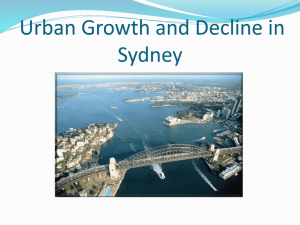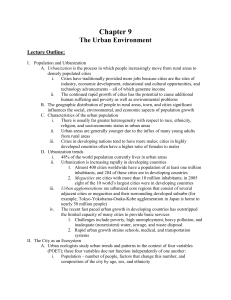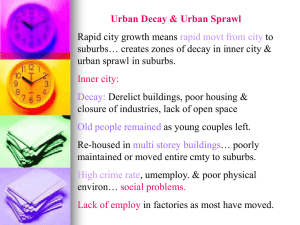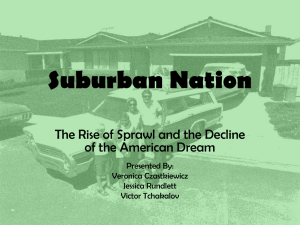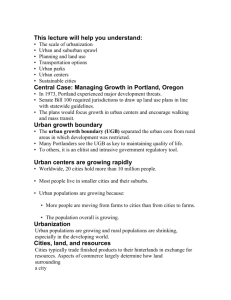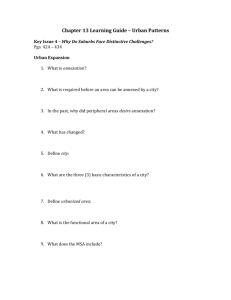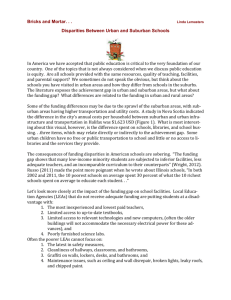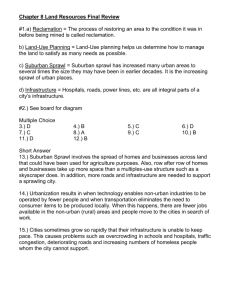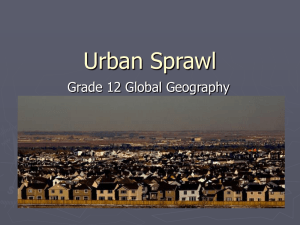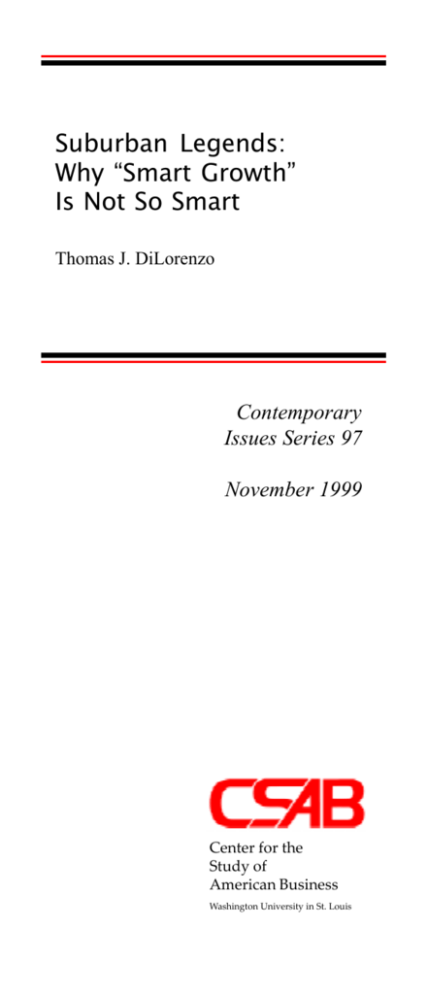
Suburban Legends:
Why Smart Growth
Is Not So Smart
Thomas J. DiLorenzo
Contemporary
Issues Series 97
November 1999
Center for the
Study of
American Business
Washington University in St. Louis
This booklet is one in a series designed
to enhance understanding of the private
enterprise system and the key forces affecting it. The series provides a forum for
considering vital current issues in public
policy and for communicating these views
to a wide audience in the business, government, and academic communities.
The Center for the Study of American
Business is a nonprofit, nonpartisan organization funded entirely by grants from
foundations, business firms, and private
citizens. Funding is unrestricted, enabling
researchers to maintain academic freedom
and ensuring unbiased and independent
research. The Center is an integral part of
Washington University, which has been
granted tax-exempt status under section
501(c)(3) of the Internal Revenue Code.
Donations to the Center qualify as charitable deductions for income tax purposes.
Donations can be made to the Center
at the following address:
Center for the Study of American Business
Washington University
Campus Box 1027
One Brookings Drive
St. Louis, MO 63130-4899
Copyright © 1999 by the Center for the
Study of American Business. All rights
reserved.
The opinions expressed are those of the
author and not necessarily those of the
Center for the Study of American Business
or Washington University.
Suburban Legends:
Why “Smart Growth” Is Not So Smart
Thomas J. DiLorenzo
Sprawl may seem an unlikely, even
arcane premise for a new political movement. Yet as the grim daily realities that
flow from unplanned development grow
more desperate, pressures for a political
response are mounting.
—David Bollier
How Smart Growth Can Stop Sprawl 1
What is politically defined as economic
“planning” is the forcible superseding of
other people’s plans by government
officials....the issue is not between
literal planning on the one hand versus
letting things happen randomly on the
other.
—Thomas Sowell
Knowledge and Decisions2
To millions of Americans, a house in
the suburbs with a nice yard, a garden,
and a little open space is the American
Dream. But to environmentalists and urban
planners it is a sheer nightmare. The
invectives used by environmentalists and
urban planners to describe suburbia
reveal a visceral hatred of it:
• Urban affairs writer Neal Pierce has
referred to “suburban sprawl” as “a virus
eating us from the inside out.”3
• The Arizona Republic has called the
suburbs “insane,” “destructive,” and
“nightmarish.”4
Thomas J. DiLorenzo is an adjunct fellow of the
Center for the Study of American Business at
Washington University in St. Louis and professor of economics at the Sellinger School of
Business and Management at Loyola College
in Maryland. The research assistance of Bruce
Bower is gratefully acknowledged.
1
• The Sierra Club views suburban development as a “menace” and a threat to our
“rural legacy” that must be eliminated.5
• Urban planner Andres Duany believes suburban sprawl is “a cancerous
growth” on society.6
• Suburban living is “something to be
opposed instead of welcomed,” according
to Vice President Al Gore.7
• New Jersey Governor Christine Todd
Whitman compares the war against suburban sprawl to the struggle against communism: “This time the enemy isn’t the
Soviets, but Sprawl.”8
The critics of suburbia have
compiled a list of alleged disasters caused by suburban living
that verges on the hysterical.
The critics of suburbia have compiled
a list of alleged disasters caused by suburban living that verges on the hysterical.
According to these critics, suburban living
is responsible for “profound environmental stress,” intractable traffic congestion,
expensive housing, loss of open space, the
virtual destruction of our cities, isolated
lives, racial segregation, loss of “historical
treasures,” “ugliness,” destruction of wetlands and recreational lands, higher taxes,
asthma among children, traffic accidents,
unemployment and poverty, destruction of
the family farm, demise of the public
schools and, according to Sprawl Watch
Clearinghouse, even the menacing spectacle of “neo-Nazi young people.” 9 Vice
President Al Gore has even stated that, in
contrast to the calm serenity of say, Manhattan traffic, driving in the suburbs is the
root cause of “road rage.”10
2
This report will argue that many of the
problems the critics of suburbia are concerned with have been either greatly exaggerated or simply fabricated. Moreover,
their proposed “solution” to these problems—centralized governmental planning
of where we live and work and how we commute (i.e., regulatory sprawl) is bound to
be economically inefficient, harmful to
growth, and inherently inequitable.
The Smart-Growth “Network”
“Smart growth” is the environmental
movement’s chosen euphemism for centralized governmental planning of where
(and how) we live and work. The essential
idea is that the free choices and careful
lifestyle planning done by individual families in cooperation with the housing industry and local public officials are inherently
“stupid” and socially destructive, whereas
the coercive planning schemes favored by
environmentalists and urban planners
are “smart” and socially enlightened. As
Thomas Sowell explains it:
Using land for what the Sierra
Clubbers like is called “saving” it,
while using it for what other people
like is called “spoiling” it. Demanding that the government prevent
other citizens from doing what
they want, in order that the environmentalists can do what they
want, is depicted as something
noble, instead of something selfish beyond words.11
The “Smart Growth Network” is a coalition of environmental organizations, urban
planners, and urban politicians. The ultimate aim of the latter group is apparently
to force people to move back into the cities
where they can pay city, rather than sub3
urban, taxes. It is a “bootleggers and Baptists” kind of coalition, to borrow economist Bruce Yandle’s phrase that he used
to describe the coalition in favor of alcohol
prohibition in the 1920s. The Baptists favored prohibition for moral reasons, while
the bootleggers wanted it for purely economic reasons—it eliminated their competition. Similarly, the attack on suburbia is
an important element of the secular “religion” of environmentalism, whereas urban
politicians are in it for the (tax) money.
In order to correct all of the supposed
inefficiencies of suburban development,
smart-growth proponents have proposed an
ever-growing list of regulations, taxes, and
myriad other government interventions, i.e.
governmental sprawl (see box, right).
Is Suburban Development Inefficient?
The charge that suburban development
is economically inefficient ignores the most
elementary of economic principles. As the
first chapter of every economics textbook
explains, allocative efficiency means that
in competitive markets, resources tend to
be used by those who value them most
highly. Those people who value a particular parcel of land more than the current
owners do, for example, will offer the owners a price they find too attractive to refuse.
It is in this way that resources tend to be
allocated to the most highly valued uses.
This is exactly what has been happening for decades as the U.S. population has
spread into the suburbs. When individuals purchase rural land to build homes, it
is by definition allocatively efficient (as is
mutually advantageous trade, generally).
Smart-growth advocates are using a bogus
definition of “efficiency” that ignores the
preferences of market participants (buyers
4
Governmental Sprawl
• Regional government, modeled after “Metro
Portland,” Oregon, that can tax and regulate land
use on a regional basis.
• Annexation of suburbs into cities, thereby
capturing their tax bases and bringing their landuse decisions under the control of urban planners.
• State government regulation of all land-use
decisions, as well as the imposition (without a popular vote) by state governments of regional taxing
authorities that can tax suburban residents to subsidize government programs in nearby cities.
• Establishment of urban growth boundaries,
beyond which development may be prohibited.
• An end to highway construction.
• A reduction of existing highway capacity
through so-called “traffic calming,” which includes
blocking entrances to highways and placing speed
bumps on highways to slow or deter traffic.
• Banning autos from shopping mall areas.
• Subsidies for mass transit.
• Government-enforced redevelopment of existing suburbs into high-density living areas consisting of apartments, townhouses, and condominiums (but no single-family houses), all
bunched together around offices and shopping
areas.
• Denial of federal highway grants (or fines
imposed by the EPA) to suburban local governments that do not go along with smart-growth
schemes.
• Regulation of banks to force them to make
more mortgage loans in cities and fewer in the
suburbs.
• Reform of state and local zoning laws to assure that they penalize or deter suburban development.
• Having the federal government scatter more
public housing projects throughout suburban areas or require developers to build such housing
as a condition of being granted building permits.
• Having the federal and state governments
buy up more land.
• Effectively abolishing large segments of rural land markets by prohibiting the sale of farmland to developers.
• Using regulation to keep “superstores” such
as Wal-Mart or The Home Depot from being built
to discourage people from shopping outside of
cities.12
5
and sellers), and simply reflects their personal preferences. Suburban residents who
have moved out of the city clearly have
decided that they are willing to endure
more time spent in an automobile in exchange for a larger house with more open
space. It is a tradeoff they are willing to
make. Smart-growth advocates are expressing their disapproval of those choices
and believe that their preferences should
be more important than the preferences of
the more than 100 million Americans who
live in the suburbs.
Smart-growth advocates ...
believe that their preferences
should be more important than
the preferences of the more than
100 million Americans who live
in the suburbs.
All the talk of “unplanned” suburban
development is also misleading. As the
quotation by Thomas Sowell at the beginning of this report states, it is not a matter
of planned versus unplanned suburban
development, but who is to do the planning.
People who build or purchase homes in the
suburbs do so as part of their work,
lifestyle, and family planning. Developers
who build houses and towns and shopping
centers for them do so because that is what
the people want. Thus, the profit motive
provides powerful incentives for developers to cater to the preferences of consumers. Those who do the best job of it will
prosper, while those who don’t will fail. This
is the very essence of economic efficiency
and involves a great deal more planning
(and more efficient planning, at that) than
can be accomplished by any governmental
planning board.
6
No such economic calculation takes
place with the centralized governmental
planning of land-use decisions that is
favored by smart-growth advocates. Such
planning would suffer from the same “pretense of knowledge” problems (to borrow
Nobel laureate F.A. Hayek’s phrase) from
which all socialist planning schemes suffer. Without markets, where consumers
reveal their true preferences by “voting”
with their dollars and where their decisions
are guided by the price system, there is no
way to determine how to put resources to
their most highly-valued uses.13
The notion that more government control of the nation’s housing stock would
make housing more attractive or more affordable should not be taken seriously.
Public housing projects, after all, are not
noted for their beauty, safety, or economy
in construction. Building code regulation
has very significantly increased the cost of
housing; yet smart-growth regulation proposes to vastly expand government’s role
in regulating housing construction, which
can only magnify these costs. One careful
study of the effects of building code regulation by real estate economists Peter Colwell
and James Kau concluded that it does
“more mischief than good. Innovation is stymied, while codes are made increasingly
rigorous and costly,” the authors write.14
Moreover, say Colwell and Kau, building codes have been “subverted by specialinterest groups to accomplish a number of
purposes unrelated to health and safety.
These objectives range from selling more
lumber to reducing the liability of code
officials.” The economists found no body
of evidence that shows building codes improve health and safety in any way.15
Colwell and Kau favor a more freemarket approach to building regulation.
7
They propose that states require building
liability insurance and then allow the building industry to establish its own standards
in a way that will minimize its liability exposure—and health and safety problems.16
Some government policy does encourage “sprawl,” of course. Examples include
tax incentives that encourage businesses
to locate in one place rather than another;
minimum-lot zoning that artificially reduces
land density; and governmental pricing of
such services as water and electricity at
average rather than marginal cost, artificially enhancing dispersed development.
And dispersed development can create
nuisances, such as congestion, crowding,
or environmental degradation. But these
are all inefficiencies that can be altered
through privatization, tax and regulatory
reform, or common-law remedies, without
effectively eliminating the private suburban real estate market and replacing it with
a bureaucratic, command-and-control,
central planning scheme.
When smart-growth advocates argue
that suburban development imposes costs
on cities by allegedly creating poverty and
unemployment and harming public
schools, they have their causation backwards. It is the destructive policies of the
past generation of urban planners that
have led to escalating crime, unemployment, and poverty in the cities, and the
decline of the public schools. The handiwork of urban planners over the past 30
years—and the heavy tax burdens that have
accumulated to pay for all their schemes—
has encouraged millions of Americans to
leave the cities for the suburbs.
In his landmark book, The Federal Bulldozer, Martin Anderson documented in
great detail how, as early as 1962, federal
“urban renewal” programs (in force since
8
1949) had been “a thundering failure.”17
So-called urban renewal programs forcibly
displaced millions of Americans, seizing
homes, businesses, and property—sometimes with no compensation. The process
destroyed thousands of low-rent homes and
squandered billions of tax dollars.18
[Inefficiencies of dispersed
development] can be altered
through privatization, tax and
regulatory reform, or commonlaw remedies.
By 1963 more than 50,000 lower-income
families had been evicted by federal urban
planners. Most of them were forced to find
more expensive housing or live in government-subsidized housing projects that
quickly turned into dilapidated, crimeridden slums. Only half of these families
received any kind of compensation for their
property losses.19 Four times more housing units were destroyed by urban planners than were replaced, causing a housing crisis for the poor. Some 26,000 small
businesses had their property “acquired”
by the state. About one-fourth of them
ended up going out of business altogether.
Some 40 percent of all small businesses in
the urban renewal area of Providence,
Rhode Island closed their doors.20
A case can be made that no city in the
United States has been subjected to more
urban planning over the past 35 years than
has been Washington, D.C. The results
have been disastrous and are undoubtedly
the reason why thousands of former residents have migrated from the nation’s capital to the nearby suburbs. This model of
9
urban planning and social engineering now
has the highest tax burden of any local
government jurisdiction and, arguably, the
worst public services.
The District of Columbia ranks sixthhighest in corporate income tax rates of the
50 states and the District. It ranks secondhighest in per capita total tax revenues extracted from its citizens (next to Alaska,
which benefits from very heavy severance
taxes on oil). The District’s total taxes per
$1,000 in personal income are about 50
percent higher than the national average.
It has the third-highest sales tax and the
highest level of income taxation (exceeding
the national average by about 90 percent).
Washington’s property taxes are the highest among the 50 states and D.C. (about 75
percent above the national average).21
Washington, D.C. ranks second only to
Alaska in total per capita government expenditures, with a level that outstrips the
national average by about 80 percent. The
District has the highest level of per capita
government debt of any major city.22 It
spends more than any other state on welfare and primary and secondary education
and has the highest pupil-to-teacher ratio
in the nation. Despite these expenditures,
Washington, D.C.’s public schools rank
49th (among the 50 states and the District) in high school graduation rates and
usually last or near last in SAT scores.23
Despite outspending all the states in
per capita corrections expenditures (more
than 450 percent above the national average), the nation’s capital has the highest
total crime rate of any major city.24
Washington, D.C. is not unique. In his
book, The Future Once Happened Here,
Fred Siegel catalogs how urban “planning”
during the 1960s and ‘70s in New York City
drained the city of its economic vitality and
10
left it “saddled with expensive and inefficient government.”25 Similar problems, according to Siegel, were created in Los Angeles and other American cities.
The Myth of the Disappearing
Agriculture Industry
One frequently cited rationale for
smart-growth regulation is that suburban
development is allegedly eating up
America’s farmland, threatening the agriculture industry and even our ability to
feed ourselves in the future. This alleged
market failure must be remedied by regulatory restrictions on suburban development. But as the late Julian Simon demonstrated, this claim is arguably “the most
conclusively discredited environmentalpolitical fraud of recent times.”26
The facts are that non-agricultural uses
of land in the United States—cities, highways, railroads, airports—amount to only
3.6 percent of the total land (82 million
acres), and cropland has remained virtually constant, at 24 percent of the U.S. land
mass, since 1945.27 Over three-fourths of
the states have more than 90 percent of
their land in rural uses, including forests,
cropland, pasture, wildlife reserves, and
parks; and only 4.8 percent of the total land
area of the United States is developed.28
It is somewhat surprising that so much
land remains devoted to agriculture, given
the vast improvements in U.S. agricultural
productivity during the last half century.
On average, agricultural productivity increased by 1.8 percent from 1948 to 1993.
Today the agricultural sector is approximately one-and-a-half times more productive than it was fifty years ago.29 It is capable, in other words, of producing much
more food on less land.
11
Though total agricultural land (not just
that which is used to grow crops) is 20 percent less than it was in 1950, this is primarily a result of increased agricultural productivity, not sprawling suburbs.30 Moreover, the rate of loss of total agricultural
land has significantly slowed in recent
years, from a rate of 6.2 percent during the
1960s, to 5.8 percent in the 1970s, 5.0 percent in the 1980s, and 2.7 percent in the
1990s.31 These moderating trends suggest
that the forecasts of smart-growth advocates, which extrapolate historical patterns
of farmland loss, are not reliable predictors
of future conditions. The U.S. Department
of Agriculture’s Economic Research Service
concluded in 1997 that “losing farmland to
urban uses does not threaten total cropland or the level of agricultural production
which should be sufficient to meet food and
fiber demand into the next century.”32
The main reason why even more
agricultural land hasn’t been
disinvested is the massive
governmental subsidies to
agriculture.
The main reason why even more agricultural land hasn’t been disinvested is the
massive governmental subsidies to agriculture, primarily in the form of federal lowinterest loans and grants, price supports,
and quotas and tariffs on imported agricultural products. Because of these subsidies, there are many farm businesses that
are inefficiently operated and that would
not (and should not) survive were it not for
the subsidies. There are too many farms
and too many farmers if economic efficiency
is the criterion we wish to apply.
12
The notion that the conversion of farmland to suburban development is necessarily harmful to nature and the environment is also questionable. Geologist James
R. Dunn recently rejected the Sierra Club’s
assertion that suburbanization is “the biggest threat to America’s wildlife heritage.”33
Dunn observes that in many areas abandoned farmland reforests naturally, and
when people move to the suburbs, they
tend to plant profuse amounts of trees and
vegetation, which often makes better animal habitat than what was provided by
farmland. In such areas, “deer habitat improves, as does habitat for robins, woodpeckers, chickadees, grouse, finches,
hawks, crows, and nuthatches, as well as
squirrels, chipmunks, opossums, raccoons, foxes, and rabbits.”34 Dunn writes
that his own suburban property has more
than 50 bird species and notes that “the
best areas for most wildlife are the places
with abundant wood edges—the fragmented landscapes of suburbia.”35
Shedding Crocodile Tears
over Traffic Congestion
Politicians promoting smart growth
usually claim to sympathize with suburban commuters who are annoyed by too
much traffic congestion and propose to do
something about it. But the types of policies advocated by smart-growth proponents would only increase traffic congestion and exacerbate air pollution.
Smart-growth advocates do not want to
build any more highways—in the cities or
in the suburbs. Their goal is to pack the
population into the cities or into more
densely populated suburban areas. This
may lead to a slight reduction in driving
time, but combined with a large percent13
age increase in population, the inevitable
result is more traffic congestion, not less.
In fact, urban planners in Portland, Oregon,
the mecca of smart-growth advocates, have
openly stated that their objective is to
increase traffic congestion in Portland so
much, and make life so miserable for that
city’s commuters, that they will abandon
their cars. “Congestion signals positive
urban development,” they have announced.36
Portland’s urban planners are aiming
for a 65 percent increase in population
density, combined with a 4.5 percent reduction in per capita driving (an admittedly
optimistic projection), leading to a tripling
of highway congestion. Mass transit—
which is universally inefficient and inconvenient—will never be much of a substitute for the automobile.37 Even in Portland,
mass transit accounts for only 2.8 percent
of commuter trips.38
Mass transit—which is universally
inefficient and inconvenient—will
never be much of a substitute for
the automobile.
In contrast, the U.S. Department of
Transportation’s “Nationwide Transportation Survey” shows that as people and jobs
have moved to the suburbs, commuting
times have decreased from an average of
22.0 minutes per commute in 1969 to 20.7
minutes in 1995.39 Contrary to the impression most Americans have of the Los Angeles “commuting nightmare,” the typical
resident of L.A. has only a 20-minute commute to one of myriad suburban employment locations.
Air pollution has also declined as
14
America has suburbanized.40 Conversely,
according to the federal government’s
“Roadway Congestion Index,” urban areas
with higher population densities have
higher levels of traffic congestion and air
pollution, contrary to what smart-growth
advocates would have us believe.41
Sending Housing Prices
through the Roof
The principal objective of smart-growth
advocates is to significantly reduce the
supply of housing in the suburbs and to
use the tax and regulatory powers of the
state to force a segment of the population
back into the cities. The effect of such a
scheme on housing markets would be to
reduce the supply of housing in the suburbs, thereby making housing more expensive there, while increasing the demand
(and price) for urban housing. In addition,
the myriad building code and other regulations that are proposed for urban housing would increase the cost of housing. The
end result would be higher-priced housing in urban areas as well as in suburbia.
Higher housing prices caused by smart
growth would effectively constitute a regressive tax on lower-income families, who
can least afford the higher housing costs.
Regulations that limit the supply of
housing that can be built have been a part
of the environmental movement’s agenda
at least since the first Earth Day in 1970.
Growth controls were championed in the
book, The Quiet Revolution in Land Use Control, published by the federal government’s
Council on Environmental Quality in
1972. 42 The growth-control techniques
that are advocated by today’s smart-growth
proponents have been utilized for many
years in various parts of the country.
15
A variety of techniques are promoted
to ostensibly control growth. States provide subsidies to local governments that
grant property tax abatements to the owners of farms or purchase land and place it
off limits to development. Agricultural zoning that prohibits development altogether
and minimum-lot zoning, including
“superzoning” such as exists in parts of
Marin County, California, where 60-acre
lots are required, are also advocated. Moratoria on new connections to public utility
systems and higher development charges,
whereby developers are assessed hefty fees
to subsidize local governmental budgets
are also tools in the tinkers’ toolboxes. And
environmental hurdles such as environmental impact statements and environmental lawsuits to protect “endangered”
species such as the spotted owl or the kangaroo rat can be used to block development.43
All of these mandates,
regulations, lawsuits, and
taxes can add significantly
to the cost of housing.
All of these mandates, regulations, lawsuits, and taxes can add significantly to
the cost of housing. California experimented with them as much as any state
during the 1970s and 1980s. Looking back
at these experiments can provide important lessons with regard to the likely effects of a new round of growth controls.
In California during the 1970s, development fees amounted to about $4,500 for
a modest-sized home and were as much
as $7,400 in San Clemente.44 California’s
adoption of growth-control regulations
16
doubled the time required for construction
plan approvals from one to two years between 1970 and 1975 and to two-and-ahalf years by 1980. Because developers
operate mostly with borrowed money, the
regulatory delays force them to spend more
on carrying charges on their loans, taxes,
insurance, and property maintenance.
Consequently, the regulatory delays
caused California housing prices to increase by as much as 21 percent.45
Regulatory restrictions on the supply
of land available for home building drove
up lot prices in southern California by more
than 500 percent between 1972 and
1978. 46 Marin County’s “superzoning”
forced so many people to choose neighboring Sonoma County as their place of residence that housing prices skyrocketed
there, leading Sonoma County officials to
file a class action lawsuit against Marin
County to attempt to get it to revise its landuse controls to allow the development of
moderate-income housing.47
California’s Santa Barbara County imposed a water-hookup moratorium and
minimum-lot zoning during the 1970s as
part of its “comprehensive growth management” plan. The effect was a sharp escalation in housing prices. Between 1967 and
1972, before the growth-control policies
were put into effect, the mean housing
price in the county rose from $26,200 to
$36,200, or 38 percent. From 1972 to
1979, the mean house price increased by
nearly 260 percent, from $36,200 to
$193,000—three times faster than the earlier period.48
Not all of this price increase can be ascribed to growth controls, of course. This
was a period of rapid population and employment growth in southern California, which
would have increased housing demand.
17
Nonetheless, economists Lloyd Mercer and
Douglas Morgan used an econometric
model to estimate that growth controls
alone caused a 44 percent increase in
nominal housing prices in Santa Barbara
County during the 1970s.49
Marin County’s growth controls, like all
growth controls, were sold in the name of
environmental protection. But they resulted
in thousands of residents moving farther
away from the city and increasing their
commuting times, thus burning more gasoline and creating more automobile pollution.
As mentioned above, Portland, Oregon,
is the mecca of smart-growth advocates,
largely because the city established an
“urban growth boundary” in 1979 and has
perhaps the harshest growth-control policies of any city in the United States. At the
time, the boundary was said to have left
enough open space to accommodate development needs for 20 years. But by the late
1980s, population growth resulted in the
permissible area of development becoming
filled up.
While the rest of the country was mired
in a housing market slump from the late
1980s to the mid-1990s, lot prices in Portland doubled from 1990 to 1995. The
growth rate in housing prices in Portland
for the 1990-1995 period was three times
its growth rate for the 1980-1985 period.
Of the 51 largest metropolitan areas in the
U.S., Portland experienced the fifth-highest
rate of housing price appreciation between
1990 and 1995.50
Mass Transit Myths
Another key element of the smartgrowth agenda is increased government
subsidies for mass transit, particularly
buses and light rail systems (i.e., street18
cars). Though proposed in the name of economic efficiency, mass transit subsidies are
among the most inefficient of all uses of
taxpayer dollars.
Public transit ridership peaked during
the World War II years, and has declined
by about two-thirds (from 23 billion trips
annually to about 8 billion) since that time,
despite tens of billions of dollars in government subsidies.51 Public transit’s share
of urban passenger miles has fallen from
more than 30 percent in 1945 to barely
2 percent today.52
Clearly, public transit is what economists call an “inferior good”—consumer
demand for the good declines as income
rises.53 The two-thirds reduction in public
transit ridership took place during the
same time that per capita personal income
in the United States rose from just over
$1,200 (in 1945) to approximately $25,000
today, a 120 percent increase in real
terms.54 The free market worked quite efficiently as consumers chose to travel more
by automobile and the auto industry accommodated them with better cars.
Smart-growth advocates complain that
automobile travel has been subsidized by
the government and that their proposals
seek to correct this government-induced
distortion. While it is true that building the
interstate highway system subsidized automobile travel, it is not at all clear that,
on net, government policy has artificially
stimulated automobile travel above what
it would otherwise have been. Drivers have
been paying very heavy federal and state
gasoline taxes for decades, which tend to
reduce the number of miles driven. Other
governmental policies such as environmental and safety regulations have increased
the price of cars, and, thus, the cost of auto
travel. We do not know what kinds of roads
19
might have been built had private entrepreneurs been given more leeway in building interstate highways, much as James J.
Hill built a transcontinental railroad in the
nineteenth century without a dime of government subsidy, not even land grants.55
Government subsidies to public transit
have been a futile, wasteful, and sometimes
corrupt attempt to foil the efficiency of the
marketplace by subsidizing less-efficient
means of transportation. Federal, state, and
local governments have poured more than
$155 billion into public transit since the
federal government first became involved in
1964. The inefficiency (in terms of transit
system deficits) has only gotten worse with
each passing year. In 1965, public transit
systems in the United States incurred cumulative deficits of $10 million, which rose
to $1.7 billion by 1975; to $8.8 billion by
1985; and to some $16 billion today.56 Perpetual deficits mean that government-run
transit systems are systematically converting transportation resources from morevalued to less-valued uses.
Every single public transit system with
a rail element in the United States operates at a loss, according to the American
Public Transit Association. In no city do
riders pay even half the cost of their own
transportation. The highest rider share of
total cost is in New York City, where riders
pay 36 percent.57
The cost per passenger mile for mass
transit is about 58 cents, compared to 41
cents for operating a car.58 And that doesn’t
count the very real cost of walking to a bus
stop or train station, waiting in the cold or
heat, being crowded in a seat with a stranger,
riding while standing up, and all the other
inconveniences of socialized transit.
Mass transit not only costs more than
automobile travel; it is also slower. The
20
average time spent commuting to work by
car in this country is 21 minutes compared
to the average 38-minute bus trip or 45
minutes by rail or subway.59 Public transit
systems with a rail component even consume 22 percent more BTUs per personmile than automobiles (5,300 BTUs versus
4,100 BTUs).60 Public transit ridership has
remained at about 8 billion trips per year
for the past 30 years, while air quality has
improved very significantly. This suggests
that mass transit has had little or nothing
to do with improvements in air quality in
the past, and is not likely to help much in
the future.
Monopoly Government
Smart-growth policies are inherently
undemocratic, because a key component
of the overall strategy is the creation of
governmental authorities in metropolitan
areas vested with more or less authoritarian land-use powers over entire regions.
These governmental bodies are not referred
to by smart-growth advocates as monopolistic, of course. Euphemisms such as “consolidated,” “metropolitan,” or “regional”
government are used instead.
In How Smart Growth Can Stop Sprawl,
published by the Sprawl Watch Clearinghouse, David Bollier extols the virtues of
regional governance while denigrating
“wasteful, zero-sum competitions among
local governments.”61 David Rusk, who is
somewhat of a celebrity among smartgrowth advocates,62 has proposed that a
regional taxing and regulating district with
powers to tax and regulate land use in all
the counties surrounding Baltimore, Maryland, be imposed by executive order.
Since 1925, the idea of monopoly government for metropolitan areas has been
21
known by political scientists as the urban
“reform tradition.”63 The key elements of
this tradition, which were first championed
by President Woodrow Wilson, are a single
government in every urban area; few
elected officials in governments run mostly
by unelected bureaucrats; no separation
of powers within the government; and an
exceptionally powerful chief executive.64
The idea is to substitute the rule
of experts for individual
choice...smart-growth advocates
want as little citizen interference
with their plans as possible.
The idea is to substitute the rule of experts for individual choice. But in a metropolitan area with several competing governmental jurisdictions, if one imposes landuse or other policies that are not to the liking of a majority of the voting population,
the result will be out-migration of population, industry, and tax base in favor of more
favorable jurisdictions. Citizens’ ability to
“vote with their feet” imposes a degree of
discipline on government. If one’s objective
is to have a government that is the servant,
rather than master of the people, then decentralized metropolitan government is
much more conducive to that end than is
one large, monopolistic government that is
largely detached from electoral pressures.
There is much empirical support for this
proposition in the economics literature.
Writing in the National Tax Journal, David
L. Sjoquist reported the results of an econometric study that concluded that “expenditures per capita in the central city fall as
the number of jurisdictions in a metropolitan area increases.”65 A similar relationship
was found by Henry J. Raimondo writing
22
in Public Finance Quarterly;66 Delores Martin and Richard Wagner in the Journal of
Law and Economics;67 and others.
Smart-growth advocates persistently
push for annexation, consolidation, and
regional “tax-base sharing” that deprives
citizens of the benefits of greater autonomy
and creates an inherently inefficient and
uncontrollable (by taxpayers) governmental system. But then again, that is apparently the idea—smart-growth advocates
want as little citizen interference with their
plans as possible.
Conclusions
The major claims made by smartgrowth advocates do not hold up to scrutiny: There is no “crisis” of dwindling farmland. Suburbanization is not “inefficient,”
but an efficient transformation of land use
from lower-valued to higher-valued uses,
the very definition of economic efficiency.
Mass transit is less efficient and, in ways,
less environmentally friendly than is automotive travel. Regional or consolidated
metropolitan government is more expensive and less responsive to the citizenry
than is decentralized government. The kind
of planning done by millions of suburban
families, the real estate industry, and local or community officials is more efficient than the arbitrary regulatory edicts
put in place by regional planning boards.
And suburbanization has been partly
caused by failed urban policies of the past,
not the other way around, as “smartgrowth” advocates contend.
This is not to suggest that there are no
problems in real estate markets. But many,
if not most, of these problems are caused
by government intervention. Governmentowned or -regulated services routinely
23
charge prices that are closer to average
than marginal cost, which artificially
stimulates suburban development and
encourages wasteful uses of resources. The
water crisis in the eastern states during
the summer of 1999 might never have been
a crisis at all if government-owned or -regulated water companies made more use of
peak-load pricing. Political control of these
facilities—even the investor-owned ones—
is the root cause of the problem;
privatization is the solution. Private, profitseeking businesses in utilities, transportation, or any other industry have strong
incentives to set prices as close as possible
to marginal costs, which is much more
conducive to efficient resource allocation
than is the current system of politicallyestablished prices.
Congestion problems that plague so
many cities are largely due to “free” public
access to highways. Peak-load or congestion pricing significantly moderates peakhour demand in the hotel, airline, telephone, and many other businesses, but is
rarely used for roads. Two successful new
private highways in Orange County, California, use congestion pricing by charging
rush-hour motorists up to $3 to use the
roads and as little as 25 cents during nonpeak hours. Carpools are also encouraged
by this pricing arrangement and the roads
are entirely paid for by the toll revenues.
Greater use of private toll roads would
be a step in the right direction with regard
to traffic congestion, but smart-growth advocates do not seem at all interested in policies that would devolve power away from
the state and place more reliance on market forces. Thomas Sowell observes that
smart-growth advocates tend to be people
“who imagine that their own superior wisdom and virtue can determine what is
24
‘really’ more valuable, regardless of what
other people want.” It is no coincidence,
says Sowell, that the shrill cries about
urban sprawl are coming from people with
a long history of big government politics
on all sorts of other issues.68
Smart-growth advocates also place too
much emphasis on legislation and regulation as means of dealing with environmental problems when there is much evidence
that the common-law doctrines of trespass
and nuisance can—and have—dealt with
myriad environmental problems in a very
satisfactory way. One advantage of nuisance law is that proof of harm to one’s
person or property is required. Environmental standards under nuisance law can
be quite restrictive where there is clear
harm to others, and lax where there is no
real evidence of harm. This allows resources
for environmental protection to be focused
where they can do the most good. By contrast, much of zoning law and environmental regulation tends to be “one size fits all”
and, as a result, quite often imposes enormous economic costs on society for little,
if any, benefit.
Finally, it should be recognized that, as
Robert Ellickson wrote in Order Without
Law: How Neighbors Settle Disputes, people
“frequently resolve their [land-use] disputes in cooperative fashion without paying any attention to the laws that apply to
those disputes.”69 Legal and regulatory
remedies are usually much more costly
than informal means, writes Ellickson, who
catalogs how land owners have for decades
been quietly using a variety of social norms
and private contracts to resolve or avoid
land-use disputes. Such methods should
be investigated further and used as widely
as possible, for they are surely more economical (and fair) than regulatory sprawl.
25
Notes
1.
2.
3.
4.
5.
6.
7.
8.
9.
10.
11.
12.
13.
14.
15.
16.
17.
18.
19.
20.
21.
David Bollier, How Smart Growth Can Stop Sprawl:
A Fledgling Citizen Movement Expands (Washington,
D.C.: Essential Books/Sprawl Watch Clearinghouse,
1998), 2.
Thomas Sowell, Knowledge and Decisions (New
York: Basic Books, 1980), 213-214.
Steven Hayward, “Legends of the Sprawl,” Policy
Review, Sept.-Oct. 1998, 10.
Ibid.
Testimony of Kathryn Hohmann, Director, Environmental Quality Program, Sierra Club, before the U.S.
Senate Environment and Public Works Committee,
March 7, 1999.
Ibid.
“Remarks as Prepared for Delivery by Vice President
Al Gore Livability Announcement,” January 11, 1999
(available at www.smartgrowth.org).
Remarks presented by Governor Christine Todd
Whitman, Partners for Smart Growth Conference,
December 15, 1998, Austin, Texas (available at
www.smartgrowth.org).
Bollier, How Smart Growth Can Stop Sprawl, 1-10.
Vice President Al Gore’s Livability Announcement, 2.
Thomas Sowell, “Urban Sprawl...Liberal Gall,”
Washington Times, June 27, 1999, B-1.
Ibid., and David Rusk, Cities Without Suburbs
(Baltimore: Johns Hopkins University Press, 1993).
Ludwig von Mises, Economic Calculation in the
Socialist Commonwealth, (Auburn, Alabama: Mises
Institute, 1990).
Peter F. Colwell and James B. Kau, “The Economics of
Building Codes and Standards,” in M. Bruce Johnson,
editor, Resolving the Housing Crisis: Government Policy,
Decontrol, and the Public Interest (San Francisco: Pacific
Institute for Public Policy Research, 1982), 57-80.
Ibid., 77.
Ibid., 78.
Martin Anderson, The Federal Bulldozer (Cambridge:
MIT Press, 1964), viii.
Ibid., xix.
Ibid., 57.
Ibid., 68-69.
Thomas N. Edmonds and Raymond J. Keating, D.C.
by the Numbers: A State of Failure (New York:
University Press of America, 1995).
26
22.
23.
24.
25.
26.
27.
28.
29.
30.
31.
32.
33.
34.
35.
36.
37.
38.
39.
40.
41.
42.
43.
44.
Ibid., 39.
Ibid., 120-125.
Ibid., 45.
Fred Siegel, The Future Once Happened Here: New
York, D.C., L.A., and the Fate of America’s Big Cities
(New York: Free Press, 1997), p. ix.
Julian Simon, The Ultimate Resource II (Washington,
D.C.: Cato Institute, 1996).
Ibid.
Samuel R. Staley, “The Sprawling of America: In
Defense of the Dynamic City,” Reason Foundation
Policy Study No. 251, May 6, 1999, 1.
U.S. Department of Agriculture, Increases in
Agricultural Productivity, 1948-1993 (Washington,
D.C.: USDA, July 1996).
Staley, “The Sprawling of America,” 16.
Ibid.
Ibid., 21.
Carl Pope, “Americans Are Saying No to Sprawl,”
PERC Reports, vol. 17, 1999, 6.
James R. Dunn, “Wildlife in the Suburbs,” PERC
Reports, Sept. 1999, 3.
Ibid.
Randal O’Toole, “Too Smart for Our Own Good,”
Liberty, May 1999, 33.
Peter Gordon and Harry W. Richardson, “L.A. Isn’t
That Bad Compared to Portland,” The Oregonian
(Portland), February 4, 1997.
Ibid.
U.S. Department of Transportation, Nationwide
Transportation Survey (Washington, D.C.: U.S.
Government Printing Office, 1997).
U.S. Environmental Protection Agency, National Air
Quality and Trends Report (Washington, D.C.: U.S.
Government Printing Office, 1998).
U.S. Department of Transportation, Roadway
Congestion Index (Washington, D.C.: U.S. Government Printing Office, 1997).
Fred P. Bosselman and David Callies, The Quiet
Revolution in Land Use Control (Washington, D.C.:
Council on Environmental Quality/U.S. Government
Printing Office, 1972).
Bernard J. Frieden, “The Exclusionary Effect of
Growth Controls,” in M. Bruce Johnson, Resolving
the Housing Crisis.
Ibid., 25.
27
45. Ibid.
46. Ibid., 28.
47. Judson Snyder, “Rohnert Park to Marin County: A
Little Housing Help!” American Planning Association News, vol. 15, 1980, 1.
48. Lloyd J. Mercer and W. Douglas Morgan, “An
Estimate of Residential Growth Controls’ Impact on
House Prices,” in M. Bruce Johnson, editor, Resolving the Housing Crisis, 189-215.
49. Ibid.
50. Ibid., 3.
51. American Public Transit Association, Transit Fact
Book (Washington, D.C.: APTA, 1996).
52. Ibid.
53. See John Semmens, “Public Transit: A Worthwhile
Investment?” Goldwater Institute Arizona Issue
Analysis No. 144, April 1997.
54. Ibid., 3.
55. Burton Folsom, Entrepreneurs versus the State
(Herndon, VA: Young America’s Foundation, 1992).
56. American Public Transit Association, Transit Fact
Book, 1998.
57. Federal Transit Administration database
(www.fta.dot.gov>).
58. Ibid., 5.
59. Semmens, “Public Transit: A Worthwhile Investment?”, 5.
60. David Shen and Jer-Wei Wu, Commuter Rail: Stateof-the-Art (Washington, D.C.: Federal Transit
Administration, December 1992); and Wendell Cox,
The Livable American City (Washington, D.C.:
American Legislative Exchange Council, 1993).
61. Bollier, How Smart Growth Can Stop Sprawl, 33.
62. He was treated as such by the audience during a panel
discussion on “regionalism” at Loyola College in
which the author participated as a critic of Rusk’s
ideas.
63. William Anderson, American City Government (New
York: Henry Holt & Co., 1925).
64. Ibid., 641-642.
65. David L. Sjoquist, “The Effect of the Number of
Local Governments on Central City Expenditures,”
National Tax Journal, vol. 35, 1985, 79-87.
66. Henry J. Raimondo, “Leviathan and Federalism in the
United States,” Public Finance Quarterly, vol. 17, no. 2,
April 1989, 204-215.
28
67. Delores Martin and Richard E. Wagner, “The
Institutional Framework of Municipal Incorporation:
An Econometric Analysis of Local Agency Formation
Commissions in California,” Journal of Law and
Economics, vol. 20, October 1978, 409-425.
68. Thomas Sowell, “Urban Sprawl...Liberal Gall.”
69. Robert C. Ellickson, Order Without Law: How
Neighbors Settle Disputes (Cambridge: Harvard
University Press, 1991), vii.
29
Other titles available in this series:
91. State and Local Trade Sanctions: A
Threat to U.S. Interests, William H.
Lash III, July 1998.
92. Giving Away the Store: The Flaws in
EPA's Expanded Right to Know Program, William H. Lash III, August
1998.
93. How Public Policies Undermine the
Rules for Getting Rich in America,
Richard B. McKenzie and Dwight R.
Lee, February 1999.
94. A Current View of the Kyoto Climate
Change Treaty, William H. Lash III,
August 1999.
95. American Steel and International
Trade: The Challenge of Globalization,
James B. Burnham, September
1999.
96. What Do We Know about Human
Influence on Climate Change? S. Fred
Singer, November 1999.
Additional copies are available from:
Center for the Study of American Business
Washington University
Campus Box 1027
One Brookings Drive
St. Louis, MO 63130-4899
Phone (314) 935-5630

